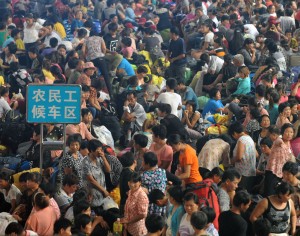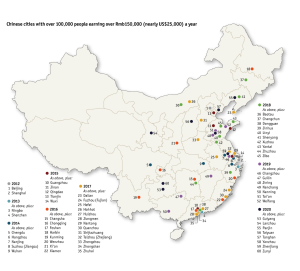Urbanisation in China’s new era
Much of the interest created by China’s rapid urban expansion is focused on infrastructural concerns such as construction, energy, sanitation and water supplies. In the following article Qian Liu from the Economist Intelligence Unit brings the focus back to the key element of urbanisation: the people.
Urbanisation is now one of the most heavily discussed topics in China, especially after being put at the top of the agenda by the new Chinese premier, Li Keqiang. The process was in fact already well under way before it was championed by Li. In 2011, China’s urbanisation rate surpassed the 50 per cent threshold for the first time, a dramatic rise from just 36 per cent in 2000.
Urbanisation is the growth of urban population due to migration and/or physical expansion of urban areas. Fundamentally it builds an increased economy of scale, and improves the country’s economic efficiency. According to our latest forecasts at the Economist Intelligence Unit, the urbanisation rate will reach 61.1 per cent by 2020. It will continue to rise until around 2050, when it will peak at 72.9 per cent, a rate comparable with many developed Western countries.
As the discussion surrounding urbanisation intensifies, certain aspects of the concept may become confusing. It is important to keep two themes in mind when discussing urbanisation:
Social welfare
China’s urbanisation is widely perceived to be a big package of various investment projects, and indeed this is, practically speaking, the easiest route for the government. It has already shown that it is willing to throw money at infrastructure, social housing, and other fixed assets investment.
However, the key concept of urbanisation is not investment, but migrants. In other words, it is not about money, but people. If migrants lack proper access to public services and do not enjoy a decent level of social welfare, the incentive to stay long in urban areas is short lived, as they will become concerned about sending their children to local schools, reimbursement for hospital visits or care for ageing parents.
At the core of China’s social welfare system is the issue of hukou reform. One of the greatest arguments for reforming the hukou system — apart from the fact it would create social parity — is that to do so would release a new wave of migrants from rural to urban areas. This in turn would help to solve the problem of labour shortages that has been exacerbated by a rapidly rising wage structure. Wages started to rise significantly from around 2003 and have been rising an average of 15 per cent per year over the past ten years. Indeed, there has been much debate over whether or not the Chinese labour market has reached the inflection point where wages will keep rising and that the era of China’s cheap labour is over — the so-called Lewis turning point.
China has certainly reached one Lewis turning point, but at the same time China is unique in that it can have more than one such inflection, with a relaxation of the hukou system refreshing the labour market with additional migrant workers. The good news is that there is plenty of reason to believe the government will take this seriously.
Income growth
A massive flow of people into urban areas is not sufficient to drive a rebalancing of the economy in which domestic and private consumption take the lead role in driving growth. Income growth, combined with a clustered and more densely concentrated population, is also required for the urbanisation drive to succeed.
Among China’s 287 prefectures: 207 have an urban population of more than one million; 86 have a metropolitan population higher than one million; and yet only 33 had an average urban disposable income higher than CNY 30,000 (around USD 5,000) by 2012.
The significance of the USD 5,000 threshold is that USD 5,000−6,000 is the international reference point at which people start to spend significantly more of their income on consumer products. And affluent as Beijing and Shanghai may seem, they only passed through this threshold in 2011 and 2010, respectively.
Encouragingly, many cities are seeing average income levels rise quickly. We forecast that by 2020, average incomes in 283 cities will have surpassed this threshold. If one looks at a higher income band of CNY 150,000 per year (around USD 25,000), only Beijing and Shanghai have over 100,000 urban inhabitants earning over this threshold. However, by 2020, this will rise to 61 cities, including inland cities like Chengdu and Xi’an.
What do these two themes mean for business? Keep an eye on where one should expand in China, and when a particular local market becomes wealthy enough to enter. Watch also for signs of reform in the hukou system, which will have an impact on wage growth and consumer power. The upcoming third plenum in November will be a key meeting, as the new Xi and Li government will make clear its intended policy direction and set the tone for potential reforms. Urbanisation, as well as some discussion of hukou reform, is likely to feature high on the agenda.
China is changing, and it is critical to keep this in mind when doing business here. China’s story is shifting from the old one of cheap labour to a new one of domestic consumption, and in this, urbanisation will play a vital role.
Qian Liu, Ph.D. is Deputy Director for the Economist Intelligence Unit’s (EIU) Access China Service. She serves as the acting head of the analysts’ team based in Beijing, London, New York and Hong Kong, and is an expert on economic analysis and forecasts on China’s provinces and 287 key prefectures. Before joining the EIU, Qian obtained her Ph.D. in Economics from Uppsala University, Sweden, and spent one year as a visiting researcher at the University of California, Berkeley. She has given presentations at various events and frequently speaks to media including the BBC, CNBC and NPR and briefs foreign corporations on China, its regional growth as well as long-term business strategies. Qian is currently based in Beijing.




Recent Comments